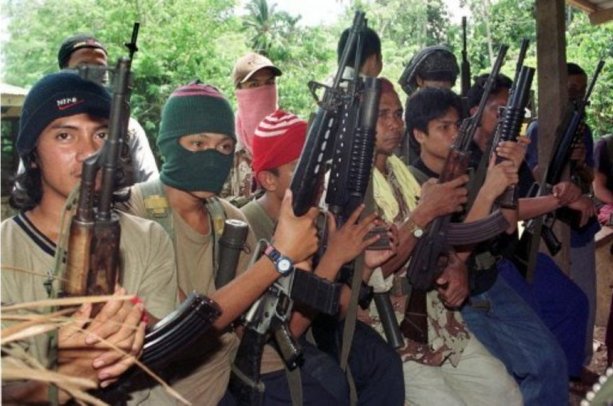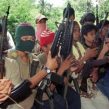
Demise of Philippines’ Abu Sayyaf Terrorist Group Begins in Abbottabad
Publication: Terrorism Monitor Volume: 9 Issue: 21
By:

The capture of Indonesian terrorist Umar Patekin in January and the death of al-Qaeda leader Osama bin Laden in May, both in Abbottabad, Pakistan, may prove to be two of the final blows to the reeling Philippines-based Abu Sayyaf terrorist group. Between January and May, the Armed Forces of the Philippines (AFP) and the Philippines National Police (PNP) further weakened Abu Sayyaf by capturing or killing a number of militants in Mindanao and Manila. The question now is whether Abu Sayyaf can still carry out terrorist attacks with their ideological leader dead, their tactical alliances with Jemaah Islamiyah (JI) and al-Qaeda disrupted and many of their core Philippine-based operatives in jail. The Philippine National Security Adviser Cesar Garcia predicts Abu Sayyaf’s “disintegration” as a result of the loss of its “leadership, people and logistics” (GMA News, May 4).
Since its formational years, Abu Sayyaf was a project of the Bin Laden terrorist network. The group emerged in the late 1980s from the most radical of the 300 – 500 Muslim mujahideen from Mindanao who were fighting the Soviets in Afghanistan with Bin Laden’s financial support. Upon returning to Mindanao to continue their jihad in the Philippines in the late 1980s and early 1990s, Bin Laden’s brother-in-law, Muhammad Jamal Khalifa, administered funding from Bin Laden and other Saudi patrons under the name of the Islamic International Research Institute (IIRI) to Abu Sayyaf. Abu Sayyaf was then a new Moro National Liberation Front (MNLF) splinter group led by Basilan native and former Afghan jihadi Abdurajak Janjalani.
Throughout the 1990s, Bin Laden sent emissaries and explosives experts to train Abu Sayyaf terrorists in the mold of al-Qaeda. He intended for Abu Sayyaf to be al-Qaeda’s Southeast Asian wing—a partnership that lasted until Bin Laden’s death. [1] Funded and inspired by Bin Laden, Abu Sayyaf’s bombing in 2004 of the Super Ferry 14, which killed more than 100 people, was the Philippines’ “9/11” (Philippine Daily Inquirer [Manila], May 4). Umar Patek’s capture on the way to meet bin Laden in Abbottabad in January is evidence that Abu Sayyaf operatives were seeking bin Laden’s patronage and guidance as late as 2011. Now the group will have to manage to survive as a jihadist organization without his overall leadership.
Patek, an Indonesian of Yemeni origin and career member of JI and the Sulewesi-based Komite Aksi Penanggulangan Akibat Krisis (KOMPAK—Crisis Management/Prevention Committee) militant group, joined with Abu Sayyaf in 2002 when he escaped into southern Mindanao after helping to mastermind the 2002 Bali bombings. While based in Mindanao from 2002 to 2010, Patek shared his IED expertise and jihadist ideology with Abu Sayyaf in return for protection, and set up a JI training camp. His presence assured that Indonesian terrorists were welcomed within the Abu Sayyaf ranks. He was also close enough to the al-Qaeda and JI leadership to serve as Abu Sayyaf’s finance officer and to provide Abu Sayyaf with a crucial link to Bin Laden, albeit unsuccessfully in the end (Manila Standard Today, March 31).
The links between Abu Sayyaf and foreign terrorist organizations are now irreparably severed. Bin Laden is dead, Patek is in Pakistani custody awaiting extradition—possibly having revealed valuable intelligence during interrogation—and the courier-facilitator system that led Patek to Bin Laden’s hideout is exposed. In addition, on March 9—after Patek was captured, but before Pakistan made a public announcement—President Susilo Bambang Yudhoyono of Indonesia and President Benigno Aquino III of the Philippines signed a Memorandum of Understanding that delineated the two countries’ maritime boundaries and focused on combating terrorism and coordinating air and sea patrols (Jakarta Globe, March 9, 2011). This could lead to greater cooperation between the two countries on shutting Mindanao’s “backdoor” to Indonesia, thus preventing JI terrorists from replenishing Abu Sayyaf’s ranks.
Abu Sayyaf is facing trouble from events transpiring abroad as well as at home. AFP and PNP operations in the first half of 2011 have led to the capture or killing of a number of Abu Sayyaf members. The AFP’s revamped counter-terrorism strategy, announced toward the end of 2010, keeps Abu Sayyaf on the run in its bases in Basilan and Sulu, and forces its members out of their hiding spots (see Terrorism Monitor, December 2, 2010). Many Abu Sayyaf terrorists tried to blend in with locals in Manila and Cebu, only to be caught by the PNP while living and working among the population (Philippine Daily Inquirer [Manila], May 10, 2011).
• On February 3, Arabi Sali, a suspect in the 2001 Dos Palmas Resort hostage-taking, was arrested in Tawi-Tawi, Mindanao (Philippine Star [Manila], February 3).
• On March 14, Nawaf Jainuddin was arrested in the house of a former town mayor in Basilan. He was wanted in connection with the Lamitan siege of 2001 (Philippine Star [Zamboanga City], March 15).
• On March 30, Philippine army troops killed three Abu Sayyaf members during a rescue attempt of three fishermen kidnapped by Abu Sayyaf in Sulu (Philippine Star [Manila], March 30).
• On April 12, Abi Pamanay was arrested in Sultan Kudarat, Mindanao. He was allegedly a liaison between Abu Sayyaf, MILF, JI and al-Qaeda (Philippine Star [Manila], April 14).
• On April 14, Mohammed Gaddung was arrested aboard a small boat near Zamboanga City in Mindanao. He had escaped from a detention facility in Basilan in December 2009 along with 31 other prisoners, most of whom were Abu Sayyaf members (Zamboanga Times [Zamboanga City], April 15).
• On April 16, two Abu Sayyaf fighters were killed in a village in Basilan when Task Force Basilan troops encountered a group led by Nurhassan Jamiri, one of Abu Sayyaf’s most notorious leaders. Jamiri has been involved in high-profile kidnappings and ambushes and the beheading of Philippine soldiers (Philippine Inquirer [Zamboanga City], April 16, 2011).
• On May 5, Imam Arabani Jakiran was arrested in Taguig City, Manila while he was working as a security guard at an upscale condominium where many diplomats live. He has been active in kidnappings since 2001 (Philippine Star [Manila], May 7).
• On May 8, Asdatul Sahirun was arrested in Malate, Manila. He had a 3.3-million peso bounty on his head and was wanted for nine counts of murder and four counts of attempted murder from 2007 (Philippine Star [Manila], May 9).
• On May 9, Abu Sayyaf member Abdurahman Andang was arrested in Basilan (GMA News, May 9, 2011).
The AFP acknowledges the possibility of retaliatory attacks in the wake of the U.S. operation to kill Bin Laden and this string of counter-terrorism successes. Abu Sayyaf has approximately 300 fighters, which is as low as their membership has been in a decade, but there are also 20 to 30 JI members in Mindanao, several of whom have become localized by marrying Filipina women in order to forge closer ties with Abu Sayyaf (GMA News, May 5). There are also at least five al-Qaeda followers of Bin Laden in Mindanao, including Zulkifar Bin Hir (a.k.a. Marwan), a Malaysian who has had a $3 million bounty on his head since 2003, as well one as two Indonesians, another Malaysian and a Singaporean who married locally (Philippine Star [Manila], May 16, 2011).
There are signs that Abu Sayyaf will focus on kidnapping and ransom instead of terrorist operations in the near future. On May 7, ten armed Abu Sayyaf members kidnapped a Malaysian gecko trader in Sulu and demanded an 80 million peso ransom for his return. On April 29, a Filipino-Chinese businessman was taken captive in Sulu, and on March, 19 three fishermen were kidnapped in Sulu (Philippine Star [Zamboanga City], May 20). In the past, Abu Sayyaf morphed into a typical criminal mafia to fund itself when its capacity to carry out terrorist attacks, find new recruits and receive outside funding was disrupted. Now is no different, especially as the group is faced with a redoubled AFP counter-terrorism campaign.
Abu Sayyaf will probably maintain its jihadi element because of the influence of the remaining JI and al-Qaeda fighters and its own understanding of jihad in Islam, but for Abu Sayyaf to become the al-Qaeda franchise in Southeast Asia that Bin Laden once envisioned is a lost cause. The current Abu Sayyaf group lacks the connections to al-Qaeda that it once had and, given its recent setbacks, may never be able to rejoin the global jihad network in the same way it has in the past.
Notes:
1. See Zachary Abuza, “Balik-Terrorism: The Return of Abu Sayyaf.” Strategic Studies Institute, September 2005.





